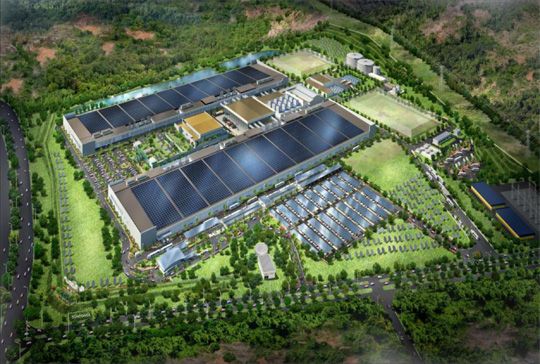On Thursday, PV efficiency leader SunPower announced the formation of a joint venture with LCD giant AU Optronics. The JV will own and operate SunPower's 1.4-gigawatt third solar cell fabrication facility (Fab 3), now under construction in Malaysia, with production slated to begin at the end of this year. SunPower and AUO will equally own the JV and contribute equal capital funding.
If AU Optronics isn't on your radar, they are a profitable, growing manufacturer of TFT-LCD displays with a market cap of about $10.7 billion. This is not AUO's first foray into the solar business; they acquired over 50 percent of M. Setek, a Japanese supplier of upstream polysilicon and wafers earlier this year.
SunPower, with a higher cost structure than its Chinese crystalline silicon rivals, has made a flurry of moves in the last few months to lower costs, control downstream channels, and improve product performance. These moves include:
- Building a system level product for modular solar farms
- Manufacturing modules with Flextronics in Milpitas, California
- Developing third-party c-Si panel channels
- Acquiring European downstream solar player SunRay
The joint venture with AUO is just the latest strategic positioning by SunPower, and it stands to lower product costs and capex and accelerate capacity ramp-up. Additionally, the firm expects to see the costs of Fab 1 and Fab 2 positively influenced by the process improvements at Fab 3.
Tom Werner, SunPower's CEO said, "We expect this JV will reduce our effective Fab 3 capital expense per watt by more than 35 percent...We believe that this JV will enable us to produce more megawatts faster, at lower cost, with substantially less cash contribution from SunPower." In the words of SunPower's CFO Dennis Arriola during yesterday's conference call, the JV "de-leverages their balance sheet."
SunPower expects the JV to cut its Fab 3 capex contribution by 50 percent and ramp Fab 3 faster with 200 megawatts of additional nameplate capacity in 2012. Under the JV, SunPower will receive 90 percent cell allocation in 2011, 85 percent in 2012 and 80 percent after 2013. Solar cells will be distributed to the JV on transfer cost and panel assembly will be handled independently. AUO has an option to sell in Asia after 2010, except in Japan and Australia, and could sell panels with JV cells in the EU.
I spoke with Julie Blunden, SunPower's VP of public policy and corporate communications, about the JV and what the solar industry needs to focus on in the coming years.
Blunden sees the JV allowing Fab 3 to grow bigger and faster and at lower costs than initial expectations. She spoke of the need for "overall equipment effectiveness" and the necessity of applying LCD-scale manufacturing to solar production. Certainly Applied Materials has attempted this, albeit with amorphous silicon and with mixed results.
With solar passing the milestone of ten gigawatts installed this year, Blunden spoke of the necessity of bringing world-class manufacturing skills to the solar industry and the need to do it quickly in preparation for the "heavy lifting" required in the solar industry's next decade of growth.
The stock markets responded with a 20 percent increase in SunPower stock as of the writing of this article.
***
Here are excerpts from feedback from the analyst community on the JV announcement:
Barclays Capital: We have maintained the view that cell cost structure can be fixed by outsourcing. The AUO cell manufacturing JV confirms our thesis -- we see this as a significant positive as it should improve depreciation costs, cash outlays (SPWRA gets 90-95% pdt for 50% capex). Lower mfg yields have been a big issue for SPWRA mfg process; AUO's mfg expertise should enable SPWRA to improve yields and enable SPWRA to reach longer-term cell processing cost targets much faster compared to prior plan. Laterals: New entrants such as AUO pose threat to existing Asian cost leaders. Also shows AUO is willing to pay extra for high efficiency technology.
Steve O'Rourke, Deutsche Bank, Equity Research division: The stated intent of the JV is to accelerate solar PV cell production. We believe the other primary reason, and potentially the more important one, is to further free up the balance sheet to more aggressively pursue the company's downstream business model. Very few companies are executing on long-term, industry-positioning strategies; SunPower is one, and we believe it will pay dividends.
Jeff Osborne of Thomas Weisel: We view the JV announcement a positive step in enhancing SunPower's manufacturing capabilities and cost reduction roadmap and accelerating progress toward below $1/W panel cost previously targeted by YE2014, which reflected about $0.20/W reduction in cell costs. We see a $0.02-0.04/watt depreciation cost savings alone from the JV. The JV would also provide a welcome reduction in cash consumption as well as financial leverage...We expect more detail on JV cost reductions, namely in reaching cost/W parity with top-tier Chinese competitors and progress on its ramp, post the close of the transaction.
SunPower is in a state of transition, from being a components-focused supplier with some systems exposure via PowerLight and a few tuck-in acquisitions, to a large-scale systems integrator with a 4 GW+ utility-scale project pipeline since the SunRay acquisition. Owning the systems channel can find a home for your product, drive greater revenue and gross margin dollars per watt; however, this process presents some risk over the long term over channel conflict, new revenue recognition rules on sale of project when a debt and equity investor is found, as well as introducing the use of 3rd party modules to a greater degree for a perceived technology leader.
Lazard Capital: We view this as a significant positive for SunPower, as it results in improved liquidity, lower manufacturing cost and faster ramp for SunPower and creates an industry-leading solar manufacturing platform...While there is limited detail on ramp schedule and cost reduction roadmap, we believe that this allows SunPower to reach its module cost target of $1.00/watt on an accelerated schedule (current target of 2014). We anticipate that SunPower will continue to command a pricing premium of about 25% versus conventional silicon players, as its high-efficiency module enables lower BOP costs.
***
Rendering of Fab 3




